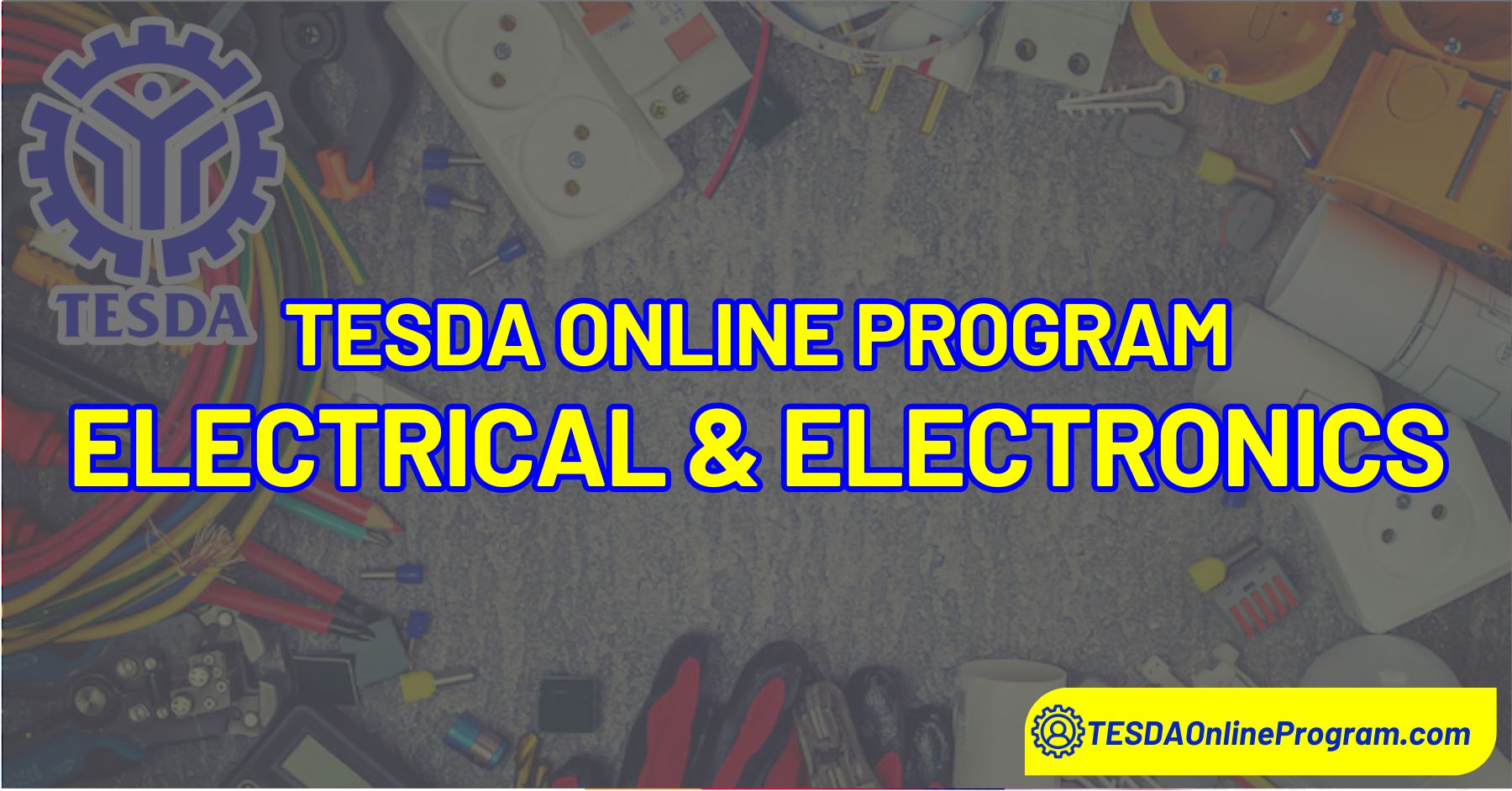The Electrical and Electronics courses, offered through the TESDA Online Program, provide accessible and quality training for individuals looking to enhance their technical skills. These courses are designed to equip learners with the knowledge and practical expertise needed to excel in various industries, making them ideal for those seeking career advancement or new opportunities in the technical field.
Also read: TESDA Consumer Electronics Servicing Courses
Among the available programs are Computer System Servicing NC II, Electrical Installation and Maintenance NC II, and Renewable/Alternative Energy. Each course focuses on essential skills, from computer hardware troubleshooting to electrical systems and sustainable energy solutions, preparing participants for in-demand roles in today’s workforce.
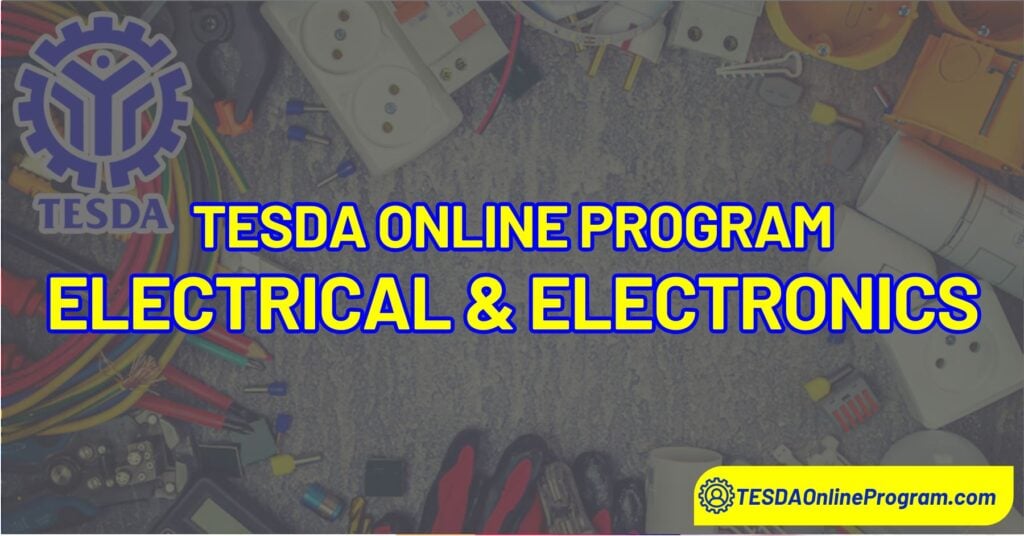
Benefits
Here are some Benefits of Electrical and Electronics Online Courses by TESDA:
- Flexible Learning: Study at your own pace and schedule, perfect for working professionals or busy learners.
- In-Demand Skills: Learn relevant skills like computer system servicing, electrical installation, and renewable energy—industries with growing demand.
- TESDA Certification: Boost your credentials with a recognized certification that improves your employability.
- Career Opportunities: Open doors to new job roles in electronics, IT, and sustainable energy sectors.
- Flexible Learning: Learn at your own pace with online tutorials and hands-on practical training sessions.
- Real-world Experience: Apply your skills in real-life scenarios during training, preparing you for the workforce.
- Free Education: Access to quality education for free, making it accessible for all individuals regardless of their financial background.
- Customizable Learning: Tailor your learning experience according to your interests and needs with a variety of courses and programs offered.
- Interactive Learning: Engage in interactive activities such as discussions, group projects, and simulations to enhance the learning experience.
- Continuous Improvement: Regular assessments and feedback help you track your progress and continuously improve your skills.
Computer System Servicing NC II
The Tesda Online Program offers courses like the Computer System Servicing NC II, equipping learners with IT skills such as setting up networks, configuring systems, and performing maintenance. The course includes five modules, each building expertise in computer servicing. Participants receive a certificate upon completing each module, showcasing their dedication to continuous learning.
Modules
There are 5 modules in the Computer System Servicing NC II course, covering various topics and skills related to computer servicing. These modules are designed to provide learners with a comprehensive understanding of computer systems and the necessary skills to perform maintenance, repair, and troubleshooting tasks.
Module 1: Introduction to CSS
This is the prerequisite module for Computer Systems Servicing NC II. Take this module before proceeding to other CSS modules. It covers the fundamentals and basics of computer systems before hands-on computer servicing.
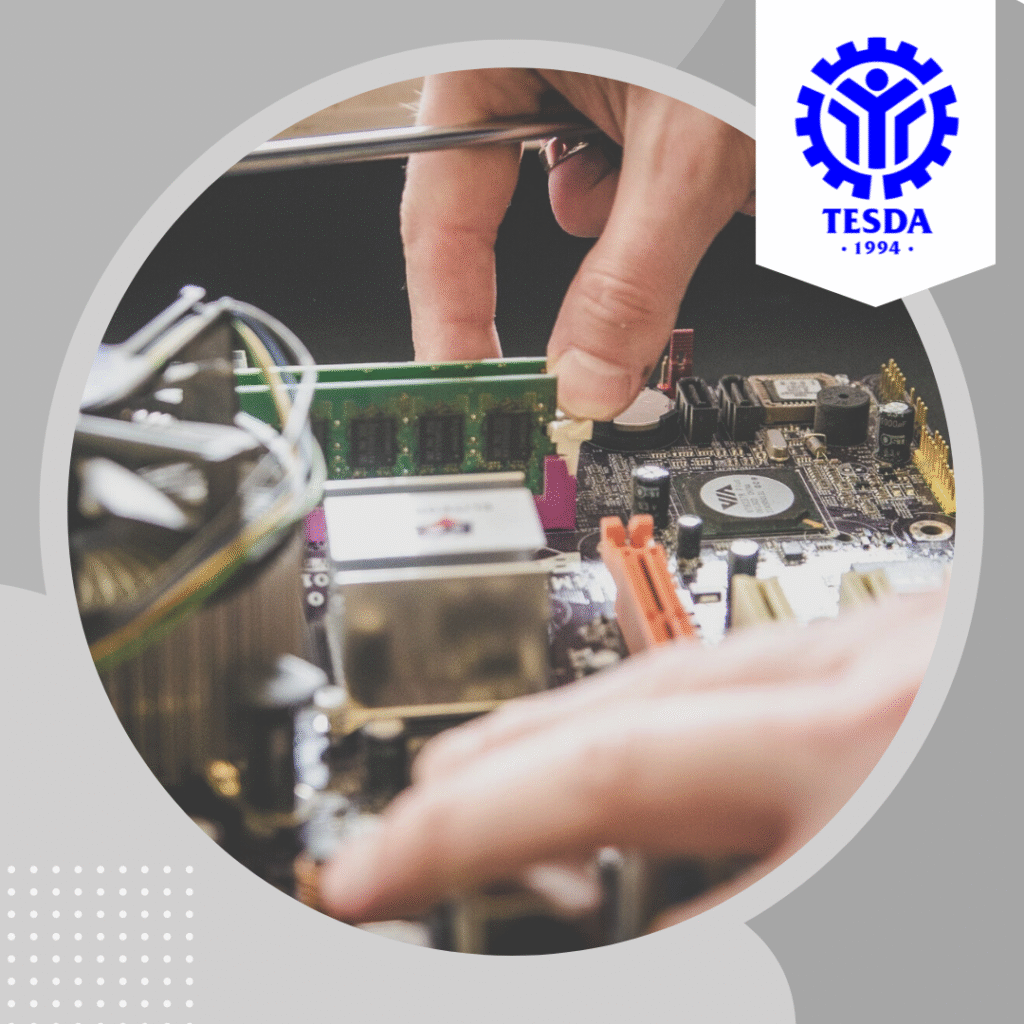
UNIT 1: Exploring the Electronics Industry
Lesson 1: CSS in the Electronics Industry
Lesson 2: OHS Policies and Procedures
Lesson 3: Applying Quality Standards
By the end of this unit, the learner must be able to:
- Identify the relevance of CSS in today’s society
- Differentiate the possible careers after achieving the CSS Qualification
- Enumerate the different Occupational Health and Safety Procedures and Policies;
- Describe the different hazards that you may encounter in the industry
- Enumerate the different forms in assessing the quality of materials
UNIT 2: Understanding Basic Computer Concepts
Lesson 1: Understanding the Computer
Lesson 2: Basic Hardware Components of Computer Systems
Lesson 3: Hand Tools and Equipment
By the end of this unit, the learner must be able to:
- Differentiate the different types of computers
- Enumerate the three fundamental elements of a computer
- Identify the different storage, processing, and Input/Output devices of a computer,
- Describe each of the components of the system unit
- Differentiate the hand tools and equipment used in computer servicing
Module 2: Installing and Configuring Computer Systems
This module covers computer hardware and software installation and configuration. It’s the second module for CSS, so complete the Intro to CSS course before proceeding. You’ll learn how to disassemble and assemble a computer, install the operating system, and necessary applications.
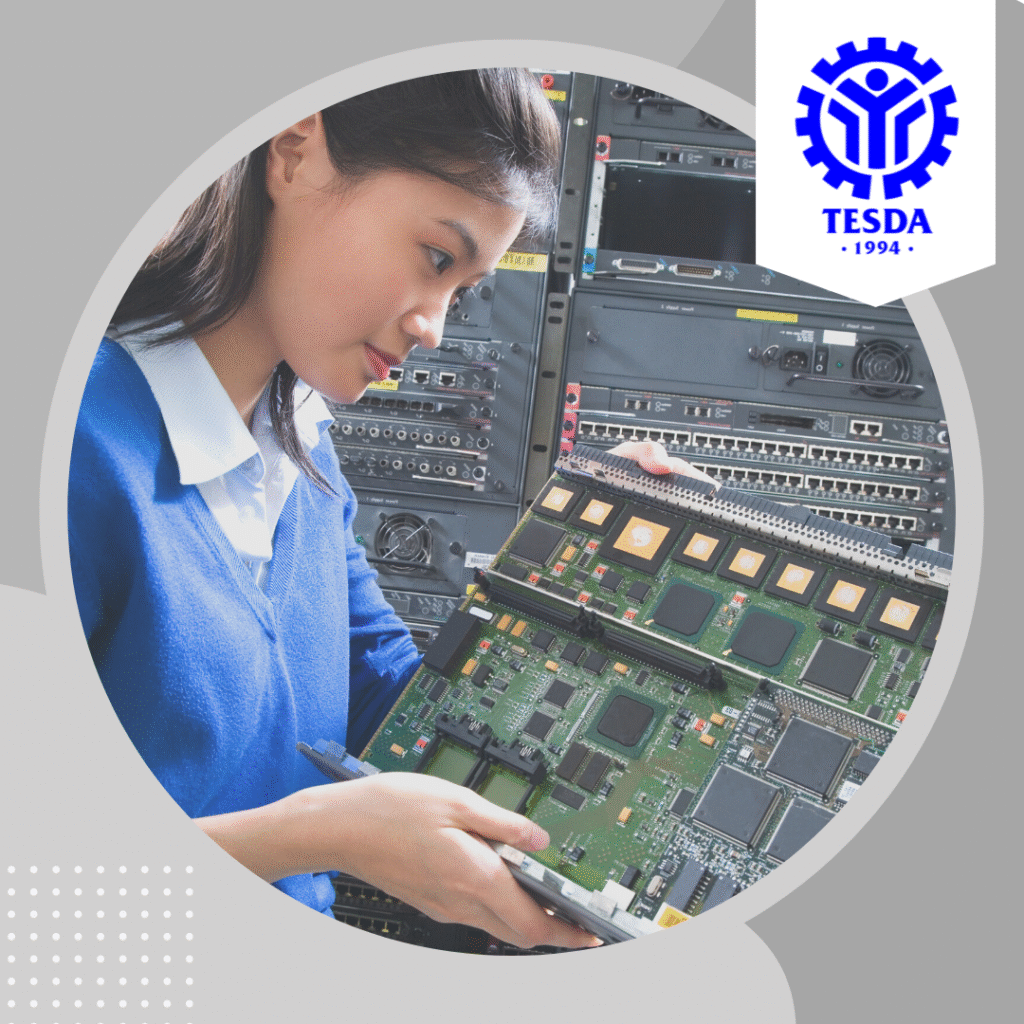
UNIT 1: Performing Computer Hardware Services
Lesson 1: Disassembling a Computer
Lesson 2: Assembling a Computer
Lesson 3: Installing I/O Devices
By the end of this unit, the learner must be able to:
- Disassemble a computer system
- Document specifications and information on hardware
- Assemble a computer system
- Install Input/Output devices
UNIT 2: Performing Computer Software Services
Lesson 1: Configuring the BIOS
Lesson 2: Installing Operating Systems
Lesson 3: Installing Device Drivers
Lesson 4: Installing Software
Lesson 5: Conducting Tests
By the end of this unit, the learner must be able to:
- Create portable boot devices
- Customize installers
- Install operating systems
- Install application software
- Conduct testing and documentation.
Module 3: Setting Up Computer Networks
This module focuses on setting up computer networks. It’s the third module for CSS, so completion of Intro to CSS and Installing and Configuring Computer Systems is important. You’ll learn how to create network cables, configure the router, and connect cables for workstations.

UNIT 1: Setting Network Configuration
Lesson 1: Understanding Network Devices
Lesson 2: Creating Network Cables
Lesson 3: Configuring the Network
By the end of this unit, the learner must be able to:
- Install network cables
- Set network configuration
UNIT 2: Setting Router and Wireless Configuration
Lesson 1: Configuring the Wireless Network
Lesson 2: Securing the Network
Lesson 3: Inspect and Test Networks
By the end of this unit, the learner must be able to:
- Set router/Wi-Fi/wireless access point/repeater configuration
- Describe basic network security components
- Inspect and test the configured computer networks.
Module 4: Setting Up Computer Servers
This module focuses on computer server setup. It is the fourth module for CSS and requires completion of Intro to CSS and Installing and Configuring Computer Systems. You will learn how to set up servers, including user access, network service configuration, and testing/documentation procedures.

UNIT 1: Set up User Access
Lesson 1: Understanding the “Server” and “Client”
Lesson 2: Creating a User Folder
Lesson 3: Configure User Access
By the end of this unit, the learner must be able to:
- Create a user folder
- Configure user access
- Perform security checks on network access
UNIT 2: Configure Network Services
Lesson 1: Checking Normal Functions
Lesson 2: Installing Modules and Add-ons
Lesson 3: Performing Network Services
By the end of this unit, the learner must be able to:
- Check the normal functions of the server
- Install and update required modules and add-ons based on NOS installation procedures
- Configure network services based on user/system requirements
- Check the operation of network services based on user/system requirements
- Respond to unplanned events or conditions.
Module 5: Maintaining Computer Systems and Networks
This module focuses on maintaining computer systems and networks. It is the last module for CSS, so it’s recommended to have completed the previous modules. However, only Intro to CSS, Installing and Configuring Computer Systems, and Setting Up Computer Networks are necessary for this module. You’ll learn how to plan and prepare for system and network maintenance, as well as inspect and test configured and repaired systems and networks.

UNIT 1: Planning and Preparing to Maintain Computer Systems and Networks
Lesson 1: Planning and Preparing for Maintenance
Lesson 2: Maintaining Computer Systems and Networks
By the end of this unit, the learner should be able to:
- Plan and prepare for maintenance of computer systems and networks
- Maintain computer systems and networks
UNIT 2: Troubleshooting Computer Systems and Networks
Lesson 1: Diagnosing Faults
Lesson 2: Correcting Defects
Lesson 3: Inspecting and Testing Computer Systems and Networks
By the end of this unit, the learner should be able to:
- Diagnose faults
- Correct defects
- Inspect computer systems and networks
Note: Upon completion of each module, or specific modules, you will be awarded a certificate to recognize your achievements and demonstrate your expertise in the respective subject matter. These certificates serve as a testament to your dedication and commitment to continuous learning.
Job Opportunities
- Technical Support Representative
- Computer Technician
- Network Administrator
- System Administrator
Demand for IT professionals keeps growing as technology advances and businesses rely more on computers and networks. Graduates of Computer System Servicing NC II can expect promising careers in various industries, including:
- Information Technology (IT) companies
- Telecommunications companies
- Business process outsourcing (BPO) firms
- Government agencies
- Schools and universities
Electrical Installation and Maintenance NC II
The Electrical Installation and Maintenance NC II online course from the Tesda Online Program provides essential skills for installing and maintaining electrical systems. Ideal for those in the construction industry or aspiring electricians, this course covers installation, testing, and maintenance of electrical systems up to 600 volts in residential buildings. Completing this course can enhance job prospects and career growth in the electrical field.
Modules
There are 4 modules in this course, each focusing on specific skills and knowledge related to electrical installation and maintenance.
Module 1: Introduction to Electrical Installation and Maintenance

UNIT 1: Overview of Electrical Installation and Maintenance
Lesson 1: The Electrical Installation and Maintenance Industry
Lesson 2: Importance of Relevant Laws and Ordinances
Lesson 3: Occupational Health and Safety Policies and Procedures
By the end of this unit, the learner must be able to:
- Define the roles and duties of an electrician
- Explain the influence of EIM in the Industry
- Identify the importance of the relevant laws and ordinances
- Practice the Occupational Health and Safety Policies and Procedures
UNIT 2: Working in the Industry
Lesson 1: Communication in the Workplace
Lesson 2: Maintaining Professional Growth and Development
Lesson 3: Entrepreneurial Skills and Values In the Workplace
By the end of this unit, the learner must be able to:
- Obtain and convey workplace information
- Work as a team member
- Identify and recommend solutions to routine problems
- Develop career and life decisions
- Contribute to workplace and community innovation
- Apply entrepreneurial best practices
UNIT 3: Fundamentals of Electrical Installation and Maintenance
Lesson 1: Basic Concepts of Electricity
Lesson 2: Different Electrical Tools and Equipment
Lesson 3: Mensuration and Calculations
Lesson 4: Interpreting Technical Drawing
Lesson 5: Applying Quality Standards
Lesson 6: Checking and Testing of Wires and Cable Layout
Lesson 7: Documentation and Reporting
By the end of this unit, the learner must be able to:
- Understand the basic concept of electricity
- Differentiate electrical tools and equipment used in wiring installation
- Perform mensuration and calculations
- Interpret technical drawings and plans
- Identify different sizes of wires and cables.
Module 2: Performing Roughing-In Activities, Wiring and Cabling Works for Single-Phase Distribution, Power, Lighting and Auxiliary Systems
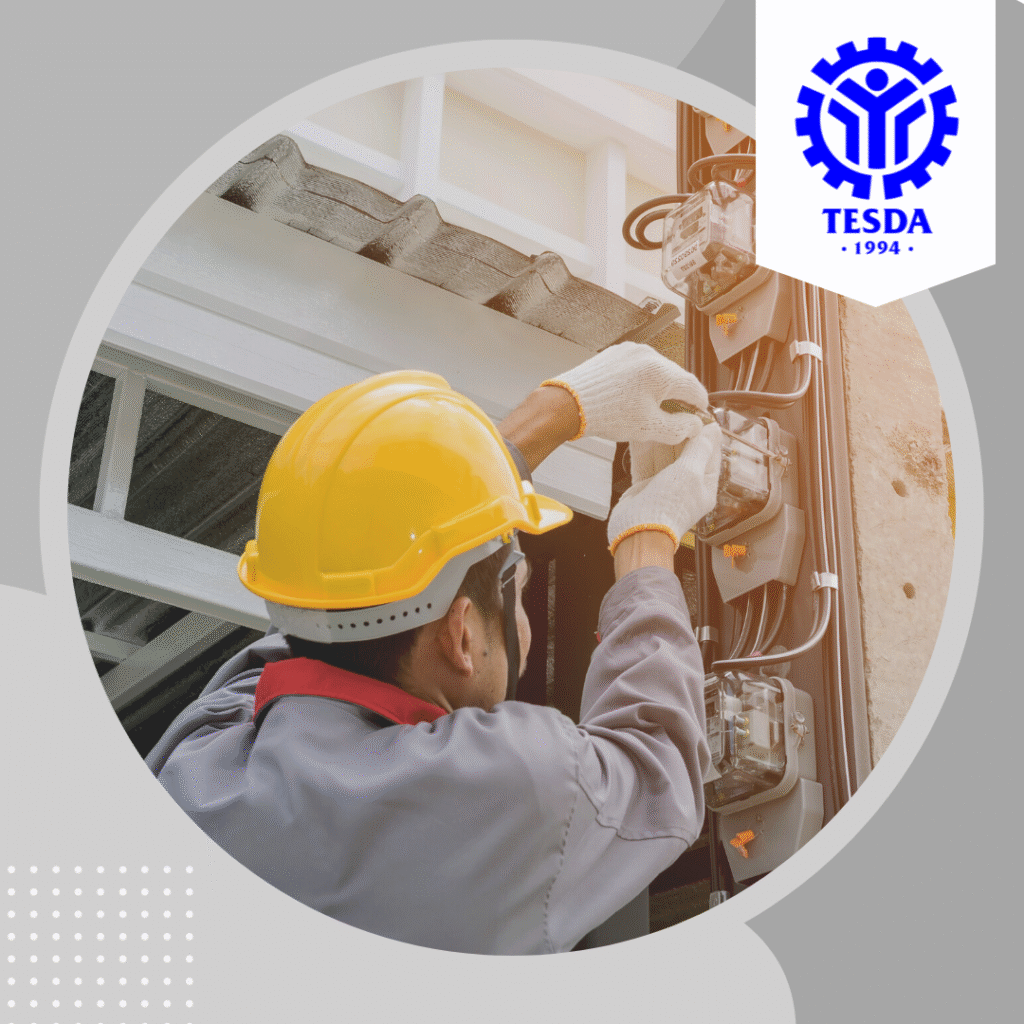
UNIT 1: Installing Electrical Metallic/Non-metallic (PVC) Conduits
Lesson 1: Electrical Conduits
Lesson 2: Conduit Bending
Lesson 3: Conduit Fittings, Adapters, Elbow and Connectors/Couplers
By the end of this unit, the learner must be able to:
- Identify the correct conduit and conduit fittings by PEC provisions;
- Select tools and equipment according to job requirements;
- Perform correct conduit installation procedures according to job requirements; and
- Value safety procedures in installing electrical conduits.
UNIT 2: Installing Wireways and Cable Trays
Lesson 1: Selecting Electrical Wire Ways and Cable Trays
Lesson 2: Installing Raceways
By the end of this unit, the learner must be able to:
- Identify the correct raceway by PEC provisions;
- Use standard tools in installing wireways and cable trays;
- Perform correct raceway installation procedures according to job requirements; and
- Value safety procedures in installing electrical raceways.
UNIT 3: Installing an Auxiliary Terminal Cabinet and Distribution Panel
Lesson 1: Installing Service Equipment
Lesson 2: Installing Panelboards/Distribution Boards
Lesson 3: Installing Auxiliary Terminal Cabinets
By the end of this unit, the learner must be able to:
- Prepare and use standard tools and equipment needed in installing auxiliary terminal cabinets and distribution panels;
- Identify PEC/NEC provisions on auxiliary terminal cabinets and distribution panels;
- Apply procedures in installing auxiliary terminal cabinets and distribution panels; and
- Value safety procedures in installing auxiliary terminal cabinets and distribution panels.
- Installing Electrical Protective Devices for Distribution, Power, Lightning Protection and Grounding Systems
UNIT 4: Performing Wiring and Cabling Layout
Lesson 1: Electrical Wires and Cables
Lesson 2: Wires and Cable Layout
By the end of this unit, the learner must be able to:
- Identify wires and cables;
- Comply with PEC/NEC provisions on wiring and cabling layout
- Apply methods in cable layout, pulling, splicing, and termination of wires
- Follow procedures in bending radius and loop tolerances for cables
- Value safety procedures in performing wiring and cabling layout
Module 3: Installing Electrical Protective Devices for Distribution, Power, Lightning Protection and Grounding Systems

UNIT 1: Installing Electrical Protective Devices
Lesson 1: Installing Electrical Protective Devices
Lesson 2: Testing Electrical Protective Devices
By the end of this unit, the learner must be able to:
- Follow safety procedures in accordance with job requirements;
- Follow the guidelines on installing electrical protective devices based on the Philippine Electrical Code (PEC);
- Identify the types and uses of protective devices;
- Perform the correct procedures for the installation of electrical protective devices in line with job requirements and PEC;
- Follow the schedule of work to ensure work is completed in an agreed time, to a quality standard, and with minimum waste;
- Seek further instructions from a supervisor if unplanned events or conditions occur; and
- Perform ongoing checks of the quality of work in accordance with instructions and requirements.
UNIT 2: Installing Lightning Protection and Grounding Systems
Lesson 1: Defining Lightning Protection and Grounding Systems
Lesson 2: Installing Lightning Protection and Grounding Systems
By the end of this unit, the learner must be able to:
- Explain the purpose of Lightning Protection and Grounding Systems
- Identify the types of Lightning Protection and Grounding Systems and their functions
- Follow the procedure for installing Lightning Protection and Grounding Systems
Module 4: Installing Wiring Devices for Floor and Wall Mounted Outlets, Lighting Fixtures, Switches and Auxiliary Outlets
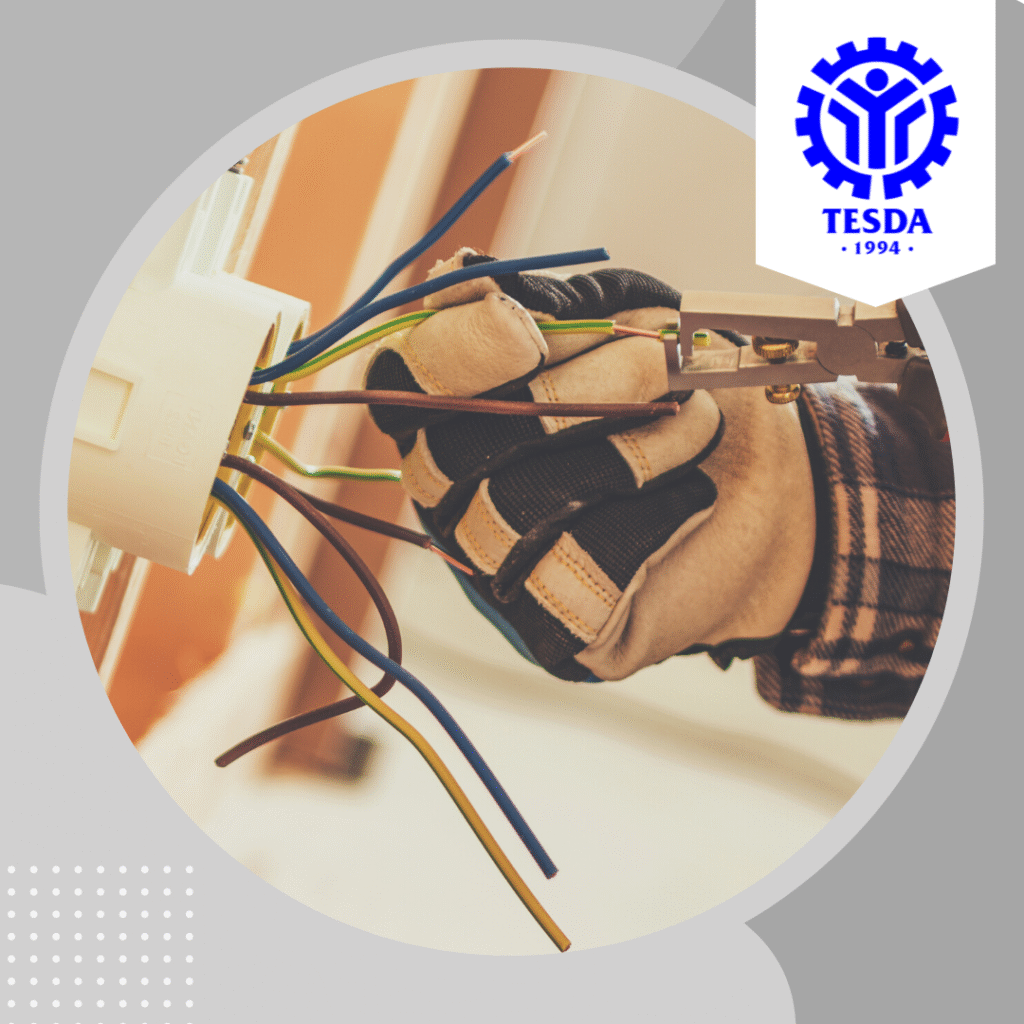
UNIT 1: Installing Lighting Fixtures/Luminaires and Switches
Lesson 1: Installing Lighting Fixtures/Luminaires & Switches
Lesson 2: Functional Testing & Troubleshooting of Lighting Fixtures/Luminaires and Switches
By the end of this unit, the learner must be able to:
- Apply different methods and techniques in installing lighting fixtures and switches;
- Perform the installation economically;
- Select and perform the installation of lighting fixtures and switches according to the PEC guidelines;
- Follow the schedule of work to ensure work is completed in an agreed time, to a quality standard, and with minimum waste;
- Seek further instructions from a supervisor if unplanned events or conditions occur; and
- Undertake ongoing checks of the quality of work in accordance with instructions and requirements.
UNIT 2: Installing Auxiliary Outlets
Lesson 1: Installing Floor and Wall Mounted Outlets
Lesson 2: Installing Auxiliary Outlets
Lesson 3: Functional Testing and Configuration of Auxiliary Outlets
By the end of this unit, the learner must be able to:
- Apply different methods and techniques in installing auxiliary outlets;
- Perform the installation economically;
- Select and perform the installation of auxiliary outlets based on the PEC guidelines;
- Follow the schedule of work to ensure work is completed in an agreed time, to a quality standard, and with minimum waste;
- Seek further instructions from a supervisor if unplanned events or conditions occur; and
- Undertake ongoing checks of the quality of work in accordance with instructions and requirements.
Note: Upon completion of each module, or specific modules, you will be awarded a certificate to recognize your achievements and demonstrate your expertise in the respective subject matter. These certificates serve as a testament to your dedication and commitment to continuous learning.
Job Opportunities
Graduates of this course can work in industries like construction, manufacturing, and maintenance. They may find roles as electrical installers or technicians for residential and commercial buildings. Possible job titles include:
- Electrical Installer
- Maintenance Electrician
- Building Electrician
- Apprentice Electrician
Renewable/Alternative Energy
The Renewable/Alternative Energy Online Course by TOP equips learners with the skills to harness renewable energy sources like solar, wind, biomass, hydropower, and geothermal energy. Ideal for those pursuing careers in sustainable energy, it covers principles, applications, and technologies while highlighting the environmental benefits and impact on climate change. This course offers practical skills for making a difference in the renewable energy sector.
Module
This online course comprises a single module, encompassing four units that will equip you with a thorough comprehension of renewable and alternative energy.
Module 1: Solar Night Light Assembly
Solar Night Light Assembly covers the knowledge and skills for assembling, testing and troubleshooting solar night lamps. It also helps deepen understanding of the process and system that converts solar energy into usable energy through solar-powered generation technology.

Unit 1: Solar Power Generation Technology
Lesson 1: What is Solar Energy?
Lesson 2: Determining Power Consumption Demands
Lesson 3: Sizing the PV modules
Lesson 4: Battery Sizing
Lesson 5: Solar Charge Controller Sizing
Unit 2: Basic Electronics
Lesson 1: Ohm’s Law
Lesson 2: Power Law
Lesson 3: Electronic Components
Lesson 4: Testing Instruments
Lesson 5: Basic Soldering Procedure
Lesson 6: Assembly
Unit 3: Assembly of Solar Lamp
Lesson 1: Printed Circuit Board Preparation
Lesson 2: Soldering Electronic Components
Lesson 3: Wirings
Unit 4: Testing and Troubleshooting
Lesson 1: Testing the Solar Night Light
Lesson 2: Troubleshooting the Solar Night Light
Note: TESDA is enhancing the Training for Work Scholarship Program (TOP) by introducing pre and post-tests. It is mandatory to complete these tests to obtain a Certificate of Completion, which guarantees the program’s excellence.
Job Opportunities
Graduates of this course can pursue career opportunities in various sectors related to renewable energy. These include:
- Renewable Energy Engineer
- Solar Panel Installer
- Wind Turbine Technician
- Biomass Plant Operator
- Hydropower Engineer
- Geothermal Energy Specialist
Summary
TESDA offers accessible and high-quality Electrical and Electronics courses through its Online Program, designed to enhance technical skills for career growth. Programs include Computer System Servicing NC II, Electrical Installation and Maintenance NC II, and Renewable/Alternative Energy, providing practical expertise in areas like hardware troubleshooting, electrical systems, and sustainable energy solutions. Perfect for those seeking new opportunities or career advancement in technical fields.
To learn how to enroll in the TESDA Online Program (TOP), click HERE.
Contact Information
Technical Education and Skills Development Authority (TESDA)
Office Address: BLDG 8, TESDA Gate 2, TESDA Complex, East Service Rd., South Superhighway, Taguig, Metro Manila.
Email Address: contactcenter@tesda.gov.ph
Telephone Number: 8887-7777
SMS Hotline: 0917-479-4370 (text only)
Website: https://www.tesda.gov.ph/
Facebook Page: https://www.facebook.com/TESDAOfficial

